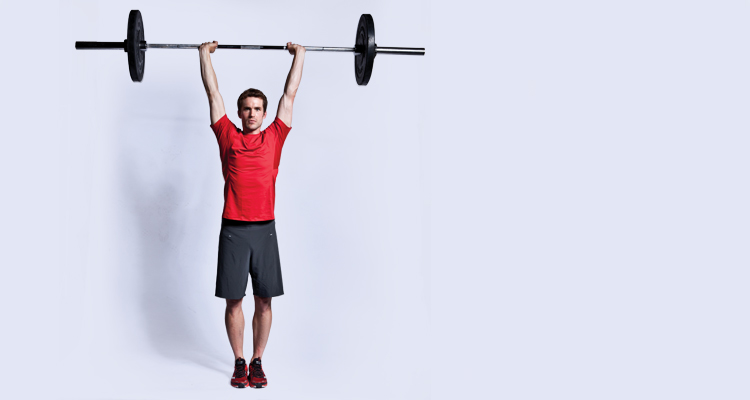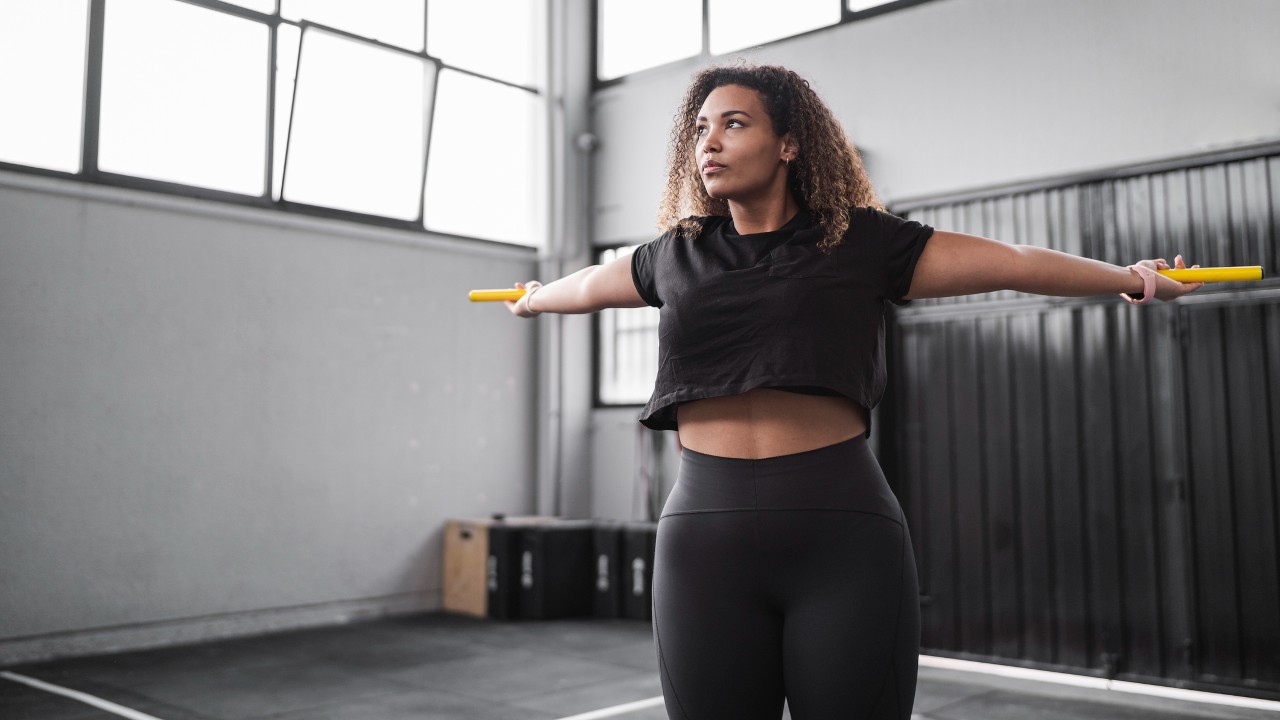How To Master The Military Press
Stand to attention to reap the abs-building benefits of the military press

Once a staple of the weights room, the military press is now something of an endangered species. The meteoric rise in popularity of the bench press is one reason for this, but the main factor in its diminishing presence is the simplest – the military press is really hard.
Fortunately you’re clearly not one to shy away from a challenge – that’s why you’re reading this guide. Below you’ll find all the information you need to nail this excellent shoulder exercise and impress at your local gym, and also correct someone when they compliment you on your overhead press. Which leads us neatly to…
What’s the difference between the overhead press and military press?
All it takes to transform your standard overhead press (which many also call the shoulder press) into a military one is to bring your feet together, in the manner of a soldier standing at attention.
It’s worth noting that the term military press is often used to describe any overhead press done with strict form, but we’re going to take a stand and say you need your feet together to call it a true military press. After all, who stands to attention with their feet shoulder-width apart? And it’s that less stable base that gives the military press its unique benefits.
Military Press Benefits
Like all presses, the military press will increase the strength of your chest, shoulders, upper back and triceps
The wider base of the overhead press – where you stand with your feet shoulder-width apart – provides a much more stable platform for the lift. When you bring your feet together, your core has to do more work to keep you stable during the lift, with your abs and obliques in particular handling more of the load.
Even though you’ll be forced to use less weight with a military press than with an overhead press, you get a better core workout during the exercise. Strengthening your core muscles in this way will have the added bonus of making you able to handle more weight when you do tackle the overhead press or push press.
In short, the military press builds both size and functional strength, making it deserving of a place in any serious training regime.
How To Warm Up Before The Military Press
Never go straight into heavy overhead presses. The ball and socket joint of the shoulder and the muscles that surround it are easy to injure, and this is one of the quickest ways to do that.
Get the Coach Newsletter
Sign up for workout ideas, training advice, reviews of the latest gear and more.

Prep your body by doing two sets of 20 shoulder dislocates with a broom handle and then two sets of 30/30 light push presses – that's 30 seconds of work, 30 seconds of rest. Do the two sets with no break, then rest for two minutes. Repeat once more and you’re ready to start working your way through your military press sets – starting light, of course.
How To Do The Military Press
Start with a barbell set up in a squat rack at mid-chest height. Take hold of the bar with your hands slightly wider than shoulder-width apart and your palms facing forwards.
Stand close to the bar and bend your knees so you’re in a quarter squat, contract your core and glutes, and drive up with your legs to stand and take the bar off the rack support. Doing it this way means your lower back is protected when you pick up the weight. Take a couple of steps back so you’ve got room to raise the bar.
Stand with your feet together, like a soldier on parade, and squeeze your glutes and core muscles hard to give you a solid base to press from. Maintain this tension throughout. If you start to go soft in the middle you’ll lose power, arch your back and put pressure on your spine. If that starts to happen, set the weight down.
Holding the bar level with your chin, make sure your elbows are pointing forwards rather than flaring out to your sides. This means you’ll recruit more of your front and side deltoids and pec muscles to help you lift heavier and with more control.
Take a sharp breath in, tense your glutes and torso, and drive the bar straight up, breathing out as you press. As you near full extension, push your head forwards so your biceps are close to your ears – this will ensure you use good form and don’t arch your back.
As you lower the bar under control to chin level, move your head back slightly so you don’t clip your forehead on the way down. Keep your core tensed throughout the set. Once you’ve put the weight down you can relax. At ease, soldier. Good job.
Military Press Form Tips
Drive through the floor
Think of each rep as a leg press or back squat and drive your feet through the floor. You want to drive down through your feet to create stability and tension in your lower body. This creates a rigid frame, which means more strength can be transferred upwards into your arms as you drive the bar up. So actively tense your glutes and quads as well as your core during every rep.
Work with your breath
“Taking a deep breath before you start the lift will help stabilise your ribcage and shoulder blades,” says strength coach Mike Causer. “Breathe out as you press the weight up and breathe in as you lower it.”
Switch on your core
Keep your core engaged when pressing the bar overhead. Not only does this protect your back from excessive strain, it creates a strong foundation from which to lift.
Hand placement
“Grip the bar with your hands just wider than shoulder-width apart so you can lock your arms out comfortably,” says Causer. “Any wider and you’ll lose drive.”
Forearm position
“Aim to keep your forearms vertical throughout the move to keep the weight balanced and put the load through the elbow rather than the wrist.”
Elbow position
“Keep your elbows vertically in line with your ears – don’t move them forwards or backwards – to make sure you press the weight up through the shortest possible distance.”
Lower to your chin
“Don’t lower the bar below your chin. If you lower the bar too far you’re likely to internally rotate your shoulders excessively and you’ll take the emphasis off your deltoids, so only go as low as your chin.”
Respect the lift
Lift with your body, not your ego, and don’t make the mistake of overloading the bar. This is a technical lift with minimal margin for error, so only lift a weight you can move with perfect form.
Military Press Variations
Dumbbell military press
Using dumbbells rather than the barbell adds another element of instability into the lift, making your core work even harder as you press the weights overhead. It’s also a good way to highlight any imbalances, because you could well be relying on one side of your body to do the bulk of the work when pressing a barbell overhead. When each side has its own weight to lift, that will iron out any strength discrepancies in no time.
Suitcase press
If you want a shoulder press that forces your core to work even harder – therefore demanding that you have your form absolutely perfect when you do military presses – try the suitcase press. Get into military press position, holding a barbell to the side of your head in one hand. You’ll need to have your hand in the middle of it to stop it toppling, and you’ll have to go super-light. Press it, making sure you don’t tilt your body to either side, then lower under control. As with the dumbbell version, working one side at a time ensures you’ll make balanced strength gains.
Arnold press
If you want one exercise to build boulder shoulders, the Arnold press could be just what you’re looking for. Popularised by Schwarzenegger himself, this movement increases the range of motion and time under tension of a standard overhead press and recruits all three heads of the deltoids (anterior, medial and posterior).
Hold dumbbells by your shoulders with your elbows bent and your palms facing you, as at the top of a biceps curl. Press the dumbbells up, rotating your palms to face forwards and moving your elbows out to the sides as you raise the dumbbells, finishing with your arms extended and biceps next to your ears.

Sam Rider is an experienced freelance journalist, specialising in health, fitness and wellness. For over a decade he's reported on Olympic Games, CrossFit Games and World Cups, and quizzed luminaries of elite sport, nutrition and strength and conditioning. Sam is also a REPS level 3 qualified personal trainer, online coach and founder of Your Daily Fix. Sam is also Coach’s designated reviewer of massage guns and fitness mirrors.
- Harry BullmoreStaff writer









